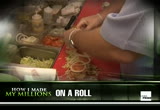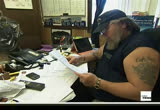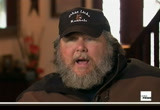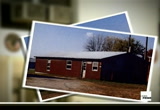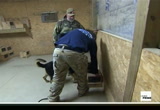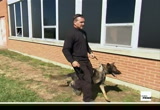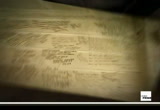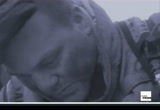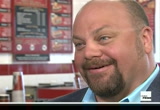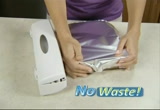tv Options Action CNBC April 20, 2013 6:00am-6:30am EDT
6:00 am
children and what you're doing with them, but the main thing i want you to know is this, there's only one thing that really matters when it comes to money, and it goes as follows, people first, then money, then things. now, you stay safe. >> what a [bleep] train wreck! >> training dogs to attack, sniff out bombs and drugs, and sink their teeth into a wealth of business opportunities. tonight -- training dogs to attack, sniff out bombs and sink their teeth into a wealth of business opportunities. and -- this was my very first product. >> a woman who helped a lot to help you find your diamond in the rough. plus -- >> two former firemen take on the sandwich and wind up with a winning combination. it's all straight ahead on an all new edition of "how i made my millions."
6:01 am
>> good evening. i'm tile ler mathisen. have you ever looked at a product or service and thought, i could do better than that? well, the people we're going to introduce you to tonight did and then they actually did it. creating successful multi million dollar companies basically by building a better mouse trap. but not without their own failure of struggles and failures along the way. when news was that s.e.a.l. team 6 used a dog to help bring down bin laden, soon came the limelig limelight. >> this is a separate kennel right here. >> ken lichleighter is a true alpha male. a retired air force dog handler who turned a fluke assignment into a luke rafb career. >> i had orders. i was leaving for korea. they put me in dog school.
6:02 am
>> his superiors signed him up for canine duty. but it was a decision that would change his life forever. >> it was a calling. i never wanted to do anything else. i worked dogs the entire time i was in the military. >> ken opted for retirement in 1993 and told his wife at the time that he had an idea. >> we had no job, no money, and we had a new house. but i knew from working with -- from being with the police department in the area for a few years, that there was a need, a real need for good dogs. >> you see, most law enforcement teams were still buying their dogs in the united states. but ken had been part of the first military unit to buy canines from european dog clubs. he knew those german shepherds and belgium malawaugh were perfect for police work. >> we could buy dogs that were a year to three years that had basic skills and we could train dogs in a third of the time.
6:03 am
>> his plan? to set up a kind of one stop shop for police canine units. he would buy the mature dogs from his overseas sources for $3,000 to $5,000, house the animals in his backyard and train them for police work. >> what a [ bleep ] train wreck. you're letting them go too soon. that's better. that's better. >> then he would sell the trained dogs for between $5,000 and $10,000 to police departments who were offered a choice of courses for an additional fee. he called his vision von lich kennels. >> it was a mom-and-pop operation from the beginning. we worked for five years clearing land and training dogs. my first kennel was an old pole barn with no concrete, dirt floors, no electricity, no water. >> and he hit some rough patches early on. >> back in '93, there was a
6:04 am
certain way to train a dog. it was aggressive for the narc dogs. when they found what they found, they would scratch and is bite and tear at it. there were times i'd be over there training, i was by myself. i would be in tears. i couldn't get a dog to do how i had been taught to do it. so i had to either fix it, come up with something that worked or go broke. a lot of stuff going on. >> so he started teaching his dogs a passive response. when detecting drugs or bombs. >> i started training mine, if it was in that drawer, they would find it and sit and stare at that drawer until the cows came home. >> how? with the help of a tennis ball. >> it's a very simple, simple process. inside that box are a group of explosive odors. we let the dog see the tennis ball going into the box, let him smell it and tell him to sit. anywhere between 500 and 1,000 times later, he sits.
6:05 am
he does it himself. within three to five 15-minute sessions, they know all the odors the. >> teaching the dogs to know all the smells at one is another of ken's innovative ideas. >> we finish our dogs in one-tenth of the time others do. >> ken teaches this technique to military canine teams, as well. he says their stories speak volumes about his effectiveness, like the one who tells about a vohne liche dog who broke free from his handler. >> the dog is sitting, staring at the ground. when they got down, they found the largest cache of weapons, munitions that had ever been found in iraq. you can train a good dog, if you make a good product, the word gets out. >> just ask shawn rump frees. >> the dog that i'm currently retiring was a vohne liche dog and it oent made sense to come back to where we got that last
6:06 am
dog because he was such a good dog. >> the long-time mom-and-pop operation still maintains a close feel. the cost for a dog, course and equipment now ranges from $10,000 to $20,000. today, vohne lichte trains about 150 handlers a year. ken says his dogs are nearly in all 50 states now. about 20 foreign countries and they work for several government agencies. >> this year, we've done contracts with million, $20 million. we're getting ready to sign a big one in saudi arabia. >> in all, the dog business puts lichleighterer's in the range. he owns this dormitory and five homes in this neighborhood, all of which he rents out to students. >> this was our very first one. >> the graffiti covered porch was testament to those trained at the kennels.
6:07 am
inside, the success stories. >> our dogs are out there fighting bad guys, finding bombs and the word got out. i pinch myself every day. >> it's not really a business. it's just a lot of fun. >> now ken is sharing it wealth using some of his kennel money to invest in other ventures. from an rv company he bought to help build and sell a better dog trailer to a farming idea he thinks can help feed the world. up next on "how i made my millions --" -- >> everything that went wrong could go wrong. >> how lori graneier got it right. check out the sweet life of sweet greens. we'll be right back.
6:10 am
>> okay, so, you reach into a drawer, rooting around for the earring or cuff link you absolutely must have tonight. you find it quick? i don't think so. now, that frustrated lori greiner, so she came up with a solution, figured out how to get it made, and convinced some big stores to sell it. millions of dollars followed from her creative solutions. back in the mid-1990s, lifelong chicago resident lori greiner had big ideas, but dreams don't pay the bills. to do that, she ran a small jewelry store, even as she wrote
6:11 am
and dabbled in scriptwriting at a theater on the north side. then came the jolting wake-up call. >> one day, talking with a girlfriend, she said, "there's no good way for people to store their jewelry." and it just instantly came to me -- literally like a lightning bolt. >> stung, she decided to shelve the writing and pursue an idea that came to her at her store. >> this was my very first product. >> greiner realized a display she'd built at her jewelry shop could work at home. >> you could hang your earrings on it. >> she envisioned a clear lucite stand and invested $10,000 to make a prototype in the spring of '96. >> i was certain that every woman in the world needed my earring organizer. >> to prove it, she took a homemade questionnaire all over chicago. >> i was sneaking in places to do it. i camped out on michigan avenue. there's the fourth pres church. i remember the pastor came out at one point and asked me what i was doing.
6:12 am
i was right in there -- right by the benches. i would say like 85% of the women all liked it, 'cause all women love jewelry. >> to mass-produce her organizer, lori read up on plastic injection molding, but simply making the mold is frighteningly expensive. >> well, i knew that to make the molds would be about $100,000. >> in july of '96, things got really serious. >> i had the courage, so i took out an enormous loan -- $300,000 loan. i think i put my condo up for collateral. >> now with a loan to pay off, lori needed a buyer -- and fast. weeks of relentless phone calls to department-store buyers unearthed at least some interest at jcpenney. >> he said, "if you can convince all the jcpenney buyers in the chicagoland area to buy it, put it in for the holiday season, and if it sells well, i'll take you nationwide." >> the buyers bought in. the retail price -- $29.85, roughly double the production cost.
6:13 am
lori's husband, dan -- a corporate comptroller at the time, now her c.f.o. -- was already crunching the numbers. >> i kind of just plotted out, well, how much could we lose here? that's all i wanted to do, was just break even, at least. >> this is the factory. >> a production run of about 10,000 earring organizers was getting under way. >> everything that could go wrong went wrong, and i was very nervous. this panel is gray, and this panel's black. the boxes came in wrong. they were black boxes that had a colored picture on it, and the bleeding of the ink had gone over the picture. >> luckily, the plant was close by, because lori spent lots of time there fixing lots of issues. >> tell me about it. we didn't know how we do it. >> lori had to rally people at the factory, like alicia macias and frank valentine. >> we didn't have that special, detailed, hands-on kind of stuff. basically, it's just shoot and ship. >> it was difficult because we don't know anything about it.
6:14 am
but she teach us. >> lori wound up spending much of the next five years at that plant because only a few weeks after the organizer went on sale at penney's, another cold call paid off. >> my customers were constantly complaining that they had no good way in which to store their earrings. >> in minutes on hsn, known as the home shopping network back in the 1990s, lori sold 500 earring organizers. >> you know what, lori? i think these are sold out. >> that was the home run. i knew that we were gonna make it. >> now here she is. >> it was more like a grand slam. competitor qvc came calling for her next big thing -- a cover. and the ideas are still coming. jewelry and storage helped lori pay off that loan in a year. >> i have sold over 450,000 of these. >> now lori can organize your handbag, your suitcase, and help you keep your kitchen clean. >> so, you can see here, it has this little "s" curve, and so you would just hang it right
6:15 am
there. so you would stir and then just hang. >> in 2011, lori had 107 patents, and new products were on the way. >> i'm working on a new design of it that will store double the capacity that the original mirror does. we've done over $500 million in retail sales. if your home environment is good and peaceful and easy, your life is better and easier. >> lori's a qvc regular now -- the rare inventor with a trusted platform to launch new products and customers who tune in to see how her gadgets can help ease their daily grind. >> that enthusiasm and passion, that's my nature, and i love seeing it in others, too. >> these days, lori can get an idea produced and on the market in about three months. and it seems like any idea that helps to uncomplicate life is a potential winner.
6:16 am
6:18 am
>> firefighters don't typically make a lot of money. some take on second jobs to help make ends meet. brothers chris and robin sorensen did that for years before deciding to turn passion for cooking into a full-time business. it took a while to get things going, but now these two are on a roll, creating bigger and
6:19 am
better sandwiches. >> welcome to firehouse. >> when we opened, something natural that just happened, that one of us would say... >> both: welcome to firehouse. >> and we're like, "man, we're just greeting people." >> brothers robin and chris sorensen want everyone to feel right at home when they come to firehouse subs. it's been that way since they opened in 1994. >> it wasn't something we drew on paper. >> all right, the number 8, the engineer -- smoked turkey. >> the two former firemen... >> large turkey. >> ...don't get behind the sandwich lines much anymore. >> where's the swiss at, chief? >> but they're still hard at work. it's the only way they know, thanks to their parents, who owned an electronics shop for 25 years. >> our dad, he's mr. patience, all right? and so, he'd come in saturday morning and he'd come in your room and flip the light on and say, "i'll be in the car." >> we had 30 people there. >> for their dad, the store was a second job. captain rob served 43 years on
6:20 am
the fire department in jacksonville, florida. >> they don't pay them enough. they don't pay fire and police enough for what they do. in 1960 till the middle-'80s, he had two jobs. >> customer service is a sorensen speciality. >> doing whatever it took and whatever they wanted done, and we didn't charge for that. >> after probably just over 20 years, they hit their largest year where they broke $1 million in this mom-and-pop tv shop, which was incredible. >> when he left home, chris tried to make it as a rock musician in washington, d.c., but wound up back in florida, fighting fires for a living. he had two kids at home and a $14,000 salary, so he and robin often teamed up in search of extra cash. >> they used to call me "odd job" because i'd, you know, whatever it took. >> we've mowed grass. we've painted houses. >> videotaping business. >> we videotape. kris kringle tree company. we don't have enough tape to go on to the disaster of that. >> we thought we could grow christmas trees in florida. >> yeah.
6:21 am
>> robin was also a firefighter for two years while his true passion smoldered. >> i really love to cook and be in that environment. we really wanted to be brewmasters. as everybody used to say, "you're a dreamer," which i've heard that a lot as a teenager -- "robin, he's a dreamer." >> yeah, and i'm gonna be a rock star. we're all dreaming, you know? >> 10 years of part-time work in the restaurant business made robin hungry to own his own place, but some family members were less than thrilled when he decided to leave the firefighting business altogether. >> he called me up and said, "dad, i'm quitting." and i just about had a heart attack. i was just devastated, but i'm glad i didn't talk him out of it. >> chris and robin figured they could out-work their competition and serve bigger, better-tasting sandwiches. but they also realized that other shops had no real atmosphere. >> in the fire department every day, the dinner table is an
6:22 am
important place for us to work our troubles out with the stuff we had to see. >> everybody loves a fireman. >> chris is the creative engine. he got a local artist to paint a mural for the first shop. now there's an original in every shop. it all looked so good on paper. >> we didn't know what the hell we were doing. >> truth is, they had no clue how much it would cost to open the first shop. they gathered some spare cash, took out a family loan, and a credit card owned by robin's mother-in-law, which they promptly overextended. >> it's laughable now. we originally talked about $5,000, and then we thought maybe even $7,000 or $10,000. and so we ended up spending about $30,000 to open the first restaurant. >> the sandwiches? >> welcome to firehouse. >> welcome to firehouse. >> well, the brothers dream up the combos firehouse is known for. >> mmm! mmm, mmm, mmm, mmm, mmm! >> turkey, meatballs, pastrami -- always piled high, plus dozens of hot sauces.
6:23 am
>> we were having the best time of our entire life. i don't think we were smart enough to probably realize what a risk we were, the fact that we opened the first week and we had like $80 left in our checking account. >> once they got cooking, it took discipline to reinvest and grow the business. >> they used to call me "dr. no" back then. i'd be like, "no. no." >> stephen joost grew up with robin and chris. he met with them just after he'd lost his job as an accountant, to discuss their finances. over chicken wings and beers, he became their c.f.o. >> we were just hoping to pay the electric and rent bill the first month, and i was just hoping to get some accounting fees out of it. i could see after we got to about 10 or 20 stores, then you can start seeing the big picture. >> now they own 29 firehouse sub shops. >> ♪ whoo! >> but that's only a fraction of the total, thanks to franchising. >> well over 400 restaurants now, serving about 700,000 customers per week. >> all: welcome to firehouse!
6:24 am
>> at the end of this year, we'll wrap up right at $300 million. >> we'll be rockin' and rollin' before too long. >> that's good. [ rock music plays ] >> now chris has his own sound studio at home. they've recorded radio commercials there. chris even wrote a song for their annual conference. >> ♪ firehouse subs is the place for you ♪ >> we never looked at it about making money for us. we just focused on how we could kick everybody's tail. funny thing is, if you're successful, you're an entrepreneur, right? we're just the same people. we're still dreamers. >> ♪ come on in >> firehouse subs has plans to top 2,000 locations by the year 2020. >> coming up on >> coming up on "millions in the making," the secret behind sweetgreen. "millions in the making," the
6:28 am
>> welcome back. tonight, we introduce a new feature called "millions in the making" -- companies that are generating a lot of buzz and are getting close to that million-dollar profit line. we begin with a story about three georgetown business school students who turned their senior project into a locally grown salad-and-yogurt experience -- now 10 locations strong and growing strong. >> sweetgreen is nathaniel ru... nicolas jammet... jonathan neman. it's called "food that fits." sweetgreen is the intersection of style and substance. we were students at georgetown, and we all took this class called entrepreneurship and decided to build a place that was healthy, fast, and cool. >> we saw this little tavern, and we fell in love with the space. >> we called the landlord.
6:29 am
she thought it was a joke. she thought it was like a school project and that we weren't actually serious about it. >> we spent our whole second semester senior year building the concept, testing recipes, coming up with employee manuals. >> we opened august 1, 2007. >> it's this concept of the sweet life -- walking into a cool atmosphere that's playing great music, knowing where your food is coming from, having a delicious salad, and being able to afford it. sweetgreen becomes part of the community, then. we connect with the local farmers. it's stimulating the local economy. it's very relationship-driven. what do you have today? >> a lot of mesclun and kale. >> we started this company to make meaning and not money. hopefully, the money will come, but really, right now, it's about having an impact in people's lives. >> we're opening these restaurants fairly quickly, so we're learning from our mistakes as we go. >> when we started, there was just three of us, and now we have over 350 employees. so we want to make s
152 Views
IN COLLECTIONS
CNBC Television Archive
Television Archive  Television Archive News Search Service
Television Archive News Search Service 
Uploaded by TV Archive on

 Live Music Archive
Live Music Archive Librivox Free Audio
Librivox Free Audio Metropolitan Museum
Metropolitan Museum Cleveland Museum of Art
Cleveland Museum of Art Internet Arcade
Internet Arcade Console Living Room
Console Living Room Books to Borrow
Books to Borrow Open Library
Open Library TV News
TV News Understanding 9/11
Understanding 9/11
